Hello fellow readers, Color in our gardens and containers impacts our lives. Then there are the other elements of the design—one of the most miraculous elements of nature, gardens, and ourselves is unseen.
What fun to attend the annual conference hosted by the NJ Landscape & Nursery Association. One of the talks I enjoyed was about Container Gardening by Bruce Crawford, Manager of Horticulture of the Morris County Park Commission.
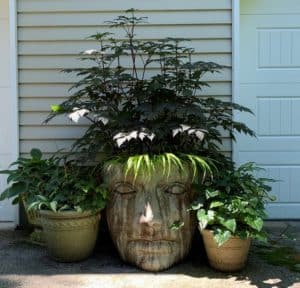
My Mother Earth Face Pot- a gift from dear clients Judy & Hector. Link to a story about – A Happy Ending to Naked Pots.
Thriller, Filler, and Spiller
You may have heard the fun-rhyming design tip for designing a container garden with a thriller, filler, and spiller. Thriller plants are the focal point, a striking vertical element such as ornamental grass, canna lily, salvia, asters, dahlias, or other spiky bloomers. The point-of-view drives the placement. I like the thriller slightly off-center when viewing the container all around. And more towards the back when viewed from the front.
Fillers are medium-sized mounding plants such as heuchera, caladiums, coleus, ageratum, petunias, or begonias. You can choose one species or two, or three as fillers. There are so many options, including lettuce and herbs that looks smashing with pansies, the flowers of which are edible.
Spillers are those that cascade over pots. Plants such as alyssum with edible flowers and nasturtium (all of the plants are edible) are ideal. There are trailing lobelia, begonia, and sweet potato vine in purple, green, or variegated, to name a few.
Consider simplicity and repetition.
And in groups, don’t put a thriller, filler, and spiller in each pot, as it will look contrived. Instead, have one thriller fill a pot. A tomato, pepper, or eggplant is ideal if you desire vegetables. Peas, pole beans, or cucumbers on a trellis or obelisk in a container work well too. Then group fillers and spillers around them in other containers.
Consider the simplicity and repetition of plants or containers when creating a grouping of pots. For example, use pots in varying sizes and textures but similar colors. Or repeat the use of some of the plants, creating a theme. Too many colors or shapes look busy or hodgepodge-y (smile).
Colors in Gardens and Our Lives
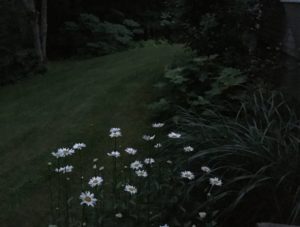
White blooms glow at dawn and dusk. Link to a story you’ll enjoy – Gardens Glow.

A cool color theme overlooks the lake.
White is the first color we see; it glows at dusk and dawn or in the light of the moon. And white intensifies the colors nearby. Red is the next color we notice after white, but a little goes a long way. It appears to advance towards you and denotes strong emotions, such as love, anger and aggression, energy, and attractiveness – increasing enthusiasm and blood pressure.
Black brightens neighboring colors though it’s nearly impossible to find in nature. Brian said black makes objects appear heavier yet thinner at the same time. (So much for choosing a black dress :^). Please forgo black mulch, though, which makes for hot unhappy plants, much like bare feet on macadam.
There’s Black Mondo Grass (Ophiopogon planiscapusn ‘Nigrescens’ – zone 5-10) and Purple Fountain Grass (Pennisetum setaceum ‘Rubrum’ zone 9-11) that are both dark purple, practically black, and are striking plants you can use.
Grey enhances neighboring colors’ purity and brightness rather than drawing attention to itself. Though Brian cited, it creates nervousness, primarily among men. (Perhaps you should change your color scheme, dear Curt?)
Night vision goggles are green, as we detect more shades of green than any other color. Green produces a calm, balanced feeling releasing tension and lessening blood pressure. Yellow stimulates the central nervous system and represents warming and liveliness, though bright yellow is hard to look at for an extended time.
Orange is invigorating and unnerving at the same time.
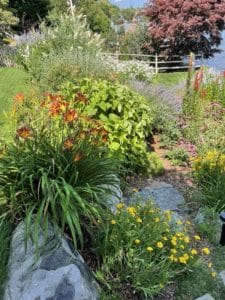
A warm color theme – Orange plays a beautiful role! We created vignettes of different color themes through the garden with all-season pops of color.

Mikey approves of the colors in the garden :^)
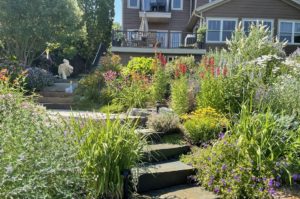
Tara enjoys color! A delight to work together on the planting plan. Hardscape by Sierra Landscape Management.
“Orange is one of the least favorite colors in a New Jersey poll,” Brian said. It’s invigorating and unnerving at the same time and can stimulate making us more social and increase appetites. Ideal for outdoor restaurants. And certainly has a beautiful place in Tara’s garden, pictured here.
Violet is the shortest visible wavelength and tends to vanish into the background; therefore, it’s difficult to see. But it is also calming, providing a warm, rich presence associated with royalty.
Blue is a pleasing background color that helps attentiveness. It can be relaxing and cooling, providing depth as blue retreats from the onlooker.
How to pick a color theme.
You can pick Monochromatic Colors combining shades of a single color. Or, remember learning about the color wheel as a child in school? It’s a perfect tool for picking color themes.
The Analogous Color Themes are next to each other on the wheel— such as a red, orange, and yellow garden. Contrasting Colors are opposite such as violet and yellow or green and red. The third color scheme is a Color Triad – triangulating the colors on the wheel, such as violet, orange, and green. Blue, red, and yellow.
Of course, color is only one variable in the garden’s beauty. There’s the texture of leaves and the structure of the plants – the other variables we see. There’s the scent, the touch, the sounds of leaves blowing in the wind or pollinators scurrying about. And the taste of plants that nourish us. Then there’s the life force, the unseen, the miracle of it all.
We plant seeds and stand in awe of what they become. Think of your life as that same miracle, and allow your unseen inner self — your love and kindness to shine and flow through you.
Garden Dilemmas? AskMaryStone@gmail.com and your favorite Podcast App.
There’s more to the story in the Garden Dilemmas Podcast:
And more of Tara and Chris’s Garden of Color to enjoy:

A Before Photo of Tara and Chris’s beautiful home.
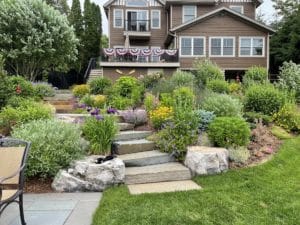
After Year One. Garden Design by Stone Associates Landscape Design & Consulting with the help of Tara (an amazing gardener). The artful hardscape by Sierra Landscape Management.


